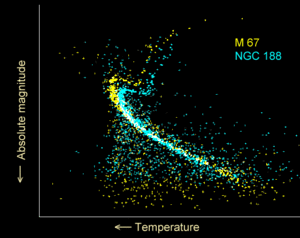This is an old revision of this page, as edited by Lithopsian (talk | contribs) at 19:35, 4 October 2018 (common synonym). The present address (URL) is a permanent link to this revision, which may differ significantly from the current revision.
Revision as of 19:35, 4 October 2018 by Lithopsian (talk | contribs) (common synonym)(diff) ← Previous revision | Latest revision (diff) | Newer revision → (diff)
The turnoff point for a star refers to the point on the Hertzsprung-Russell diagram where it leaves the main sequence after the exhaustion of its main fuel. It is often referred to as the main sequence turnoff.
By plotting the turnoff point of the stars in star clusters, one can estimate the cluster's age.
Stars with no turnoff point
Red dwarfs are stars of 0.08-0.4 solar masses and are also referred to as class M stars. Red dwarfs have sufficient hydrogen mass to sustain hydrogen fusion to helium via the proton-proton chain reaction, but do not have sufficient mass to create the temperatures and pressures necessary to fuse helium to carbon, nitrogen or oxygen (see CNO cycle). However, all their hydrogen is available for fusion, and the low temperatures and pressures mean the lifetimes of these stars on the main sequence from zero point to turn off point is measured in trillions of years. For example, the lifespan of a star of 0.1 solar masses is 6 trillion years. This lifespan greatly exceeds the current age of the universe, therefore all red dwarfs are main sequence stars. Even though extremely long lived, those stars will eventually run out of fuel. Once all of the available hydrogen has been fused stellar nucleosynthesis stops and the remaining heated helium slowly cools by radiation. Gravity will contract the star from lack of expansive pressure from fusion until electron degeneracy pressure compensates. The cooling star is now off the main sequence and is known as a helium white dwarf.
References
- Iliadis, Christian (2007). Nuclear Physics of Stars. Weinheim: Wiley-VCH. ISBN 3-527-40602-6.
- Seeds, Michael (2006). Horizons. Australia: Thomson Brooks/Cole. ISBN 0-495-01003-0.